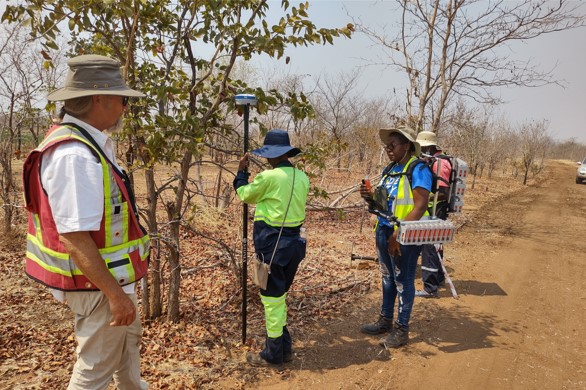Last year, Australian gas and oil company, Invictus Energy began a multi-million-pound E&P project to tap the last untested large frontier rift basis in onshore Africa – the Cabora Bassa Basin in Northern Zimbabwe.
Welcomed by locals, the project has the potential to provide a solution to the country’s energy crisis through offering Zimbabwe the chance to not only be energy independent but shift its position to that of an exporter into the region.
To explore the petroleum potential of the frontier basin, Invictus deployed a 2D seismic campaign that not only resulted in a more cost-efficient acquisition but promoted safer operations while reducing environmental impact in complex and remote terrain.
Enabling survey excellence in remote locations
Seismic, an exploration process of gathering subsurface vibrations using advanced technology to determine the existence of hydrocarbons, was implemented by Canadian seismic contractor, Polaris Natural Resources, who are on a mission to help end energy poverty in Africa by enabling operators to explore the petroleum potential beneath the flat savanna land.
Due to the remote survey location being deemed as an environmentally sensitive area, the team required an environmental impact assessment (EIA) to be completed prior to the survey being sanctioned, meaning it had to adhere to strict environmental footprint management conditions.

In addition to environmental concerns for the area, the complex terrain coupled with the survey being weather-dependent also created logistical and time challenges.
The vast survey size traditionally would have required large volumes of seismic equipment to complete the survey effectively. However, as this was a frontier, unexplored basin, Invictus Energy required a solution that was low cost, without compromising the quality of the output dataset.
With a vision to make seismic data collection more cost-effective, agile, safe and sustainable, while delivering unparalleled subsurface imaging, Stryde’s state-of-the-art Nodal technology was selected to enable this crucial land seismic acquisition.
Launched to market in 2019, the disruptive technology offers pioneering, high-density seismic imaging systems, which play a key role in the exploration and production (E&P) stage of new discoveries, or of existing reservoir management.
Adaptable for land or marine, seismic data acquisition is the process of gathering information about the composition of the earth below the surface. This data is acquired using machine receivers, which create and listen for vibrations before processing the scans into raw data.
Stryde’s Nimble system™, comprising of 9,540 Stryde Nodes™, a server and 4 Nests, navigator tablets, initiation devices, backpacks and the nodal operating software, as well as field support personnel, were delivered on-site in southern Africa within five days of the contract agreement to ensure the project started on time.

Unlocking high-density seismic, cost savings and safer working
Using 9,500 Stryde nodes, over 82,929 seismic receiver points were laid out, by foot during the survey, resulting in a total of 839.5 km of high-resolution 2D seismic data being acquired. 402 km was situated in Invictus’ Special Grant 4571 license, and another 437 km of contiguous data in an existing application area.
As well as the vast seismic data acquisition, Stryde’s system also unlocked significant cost savings, related to reductions in the number of people, equipment needed, logistics, vehicles, and project time when compared to competitor cable and nodal systems.
Utilizing the world’s smallest and lightest nodes, the locally hired teams were able to carry 90 nodes per person by foot, resulting in being able to deploy and retrieve thousands of nodes per day. This minimized the need for line clearing and land disruption, shooting the survey in a more efficient manner, which reduced the project timeline considerably.
Continuously recording nodes allowed multiple receiver lines to be generated from a single shot line, resulting in the acquisition of high-resolution and increased density 2D lines and deep structure data that provided the insights required to make informed drilling decisions and to help plan future surveys.
In addition, the unique characteristics of the Nimble nodal system™ reduces the number of people and vehicles required to deploy and retrieve the nodes in the field and therefore reduce the acquisition contractor’s exposure to risks on site.
As well as supporting the country becoming energy independent, the project also generated nearly 200 direct jobs during the campaign for the local Muzarabani and Mbire communities as well as the procurement of goods and services from local suppliers.
Promising prospects
Stryde’s Nimble system™ is ideally suited to these kinds of remote 2D operations. The speed at which locally hired teams could learn how to operate the system allowed Polaris Natural Resources to deliver a very efficient project that delivered fantastic imaging results for Invictus Energy.
High-density 2D seismic data was successfully harvested from Stryde Nodes™, before being sent for processing and interpretation, enabling the company to identify and mature additional prospects and leads.
Drilling of the Mukuya-1 well is currently underway, with the Mukuya prospect prospect considered to be the largest undrilled conventional oil and gas prospect onshore Africa. Invictus believes it could host prospective resources of about 9.25 trillion cubic feet of gas and 294 million barrels of condensate.
Stryde’s customers benefit from a substantially reduced environmental footprint, reduced HSE risk, faster surveys and significant operational and logistical efficiencies before, during and after acquisition.
To summarize, Stryde’s products save customers money and time while enabling them to deliver the best quality seismic data.
About Stryde
Stryde is helping organizations from around the globe to acquire an unparalleled understanding of the subsurface. As the creators of the World’s smallest, lightest and most affordable seismic nodes, Stryde enables high-density seismic to be affordable to any industry.
To find out more about Stryde and the game changing Stryde Node™ please visit www.strydefurther.com or email us at sales@strydefurther.com
About the prospect
Watch this video from Invictus for more information on the Mukuya prospect that is currently being drilled.

